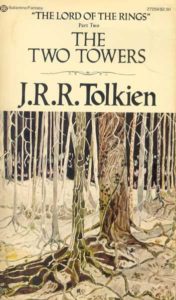Yes, Boromir failed. But he was far from alone. Denethor failed in sending a war leader on a mission meant for a diplomat. Aragorn and Gandalf failed to give him his due, and after that they failed to recognize that they were freezing out their proud companion. Despite their supposed wisdom, they did not see that being right is not enough.
Yet the last words that Boromir hears are words of compassion, a promise to complete his task, words that, perhaps, eased his passing. This time through The Lord of the Rings, I was surprised at how often I encountered that compassion, though Tolkien generally calls it pity. Frodo has pity on Gollum, not only taming him and persuading him to lead Frodo and Sam through the Dead Marshes toward Mordor, but later persuading Faramir to spare Gollum after he has stumbled into the southern rangers’ sanctuary. Gandalf pities Saruman, when they parley among the ruins of Isengard. Sam pities the Oliphaunt, whose appearance in Ithilien foreshadows the presence of many more in the War of the Ring. And though Faramir’s men pity the other men that they ambush, it does not stop them from slaying as many as possible. There is compassion in war, Tolkien says, but it remains war.
Hoom, hoom! Treebeard remains one of the special delights of The Two Towers, at once old even by Elvish standards and at times oddly adolescent. The tale of the Ents and the Entwives did not seem sad to me, more sort of charmingly awkward. The Ents may be thousands of years old, yet somehow they remain tongue-tied boys at their first school dance. The Entwives, I think, gave up in exasperation. The Huorns are probably the scariest life-forms in Middle Earth that are not in the service of Sauron, and a reminder of how much of Tolkien’s created nature is hostile to his protagonists.
As Frodo and Sam draw closer to Mordor, I was surprised how often Frodo seemed to sense events to his west, among the other members of the company. The time in Ithlien and with Faramir was also longer than I remembered. Tolkien uses those chapters to set up the coming War of the Ring from the perspective of people who know little or nothing of the Ring itself. The rangers of the south, like the other men of Minas Tirith see Mordor pouring forth its strength, knowing that they will bear the brunt of Sauron’s wrath for reasons they cannot begin to be aware of. Tolkien makes Ithilien especially beautiful, perhaps a Flanders before the Great War, counterpoised to the Dead Marshes, which are very much like the Low Country mud he would have slogged through during his wartime service.
The book ends with the First Age erupting into the final days of the Third: Shelob is a bane separate from Sauron, no less steeped in malice but without the desire to rule. She is daunted by the phial that Galadriel has given to Frodo, which contains light from the Two Trees from the very beginning of the world. That same scene, though, points toward the next age, with the most important choices being made by the person with the lowest social standing. Not a lord of the Noldor but Samwise the gardener is the person who saves the quest when it is in greatest danger. The orcs make the mistake of thinking that only a great elf fighter could have driven off Shelob. They have the Ring-bearer, but not the Ring; at the end of this middle book (which has classic middle-book structure, solving some problems and ending with a cliffhanger), the quest hangs by a thread. That much, at least, is every bit as gripping as I remember.

